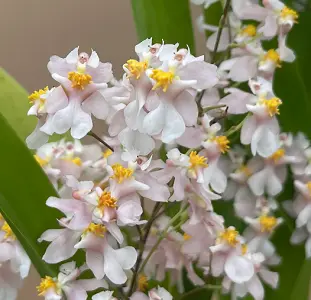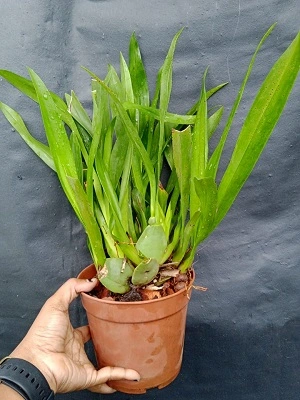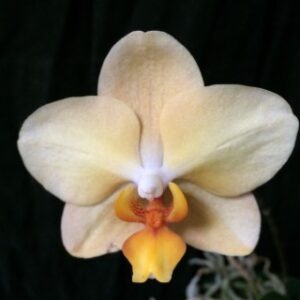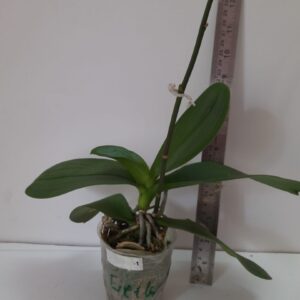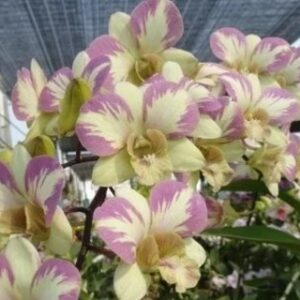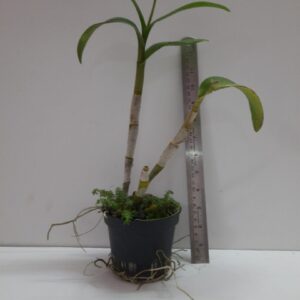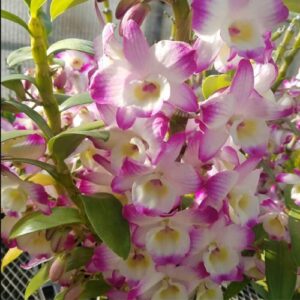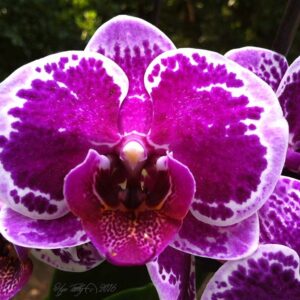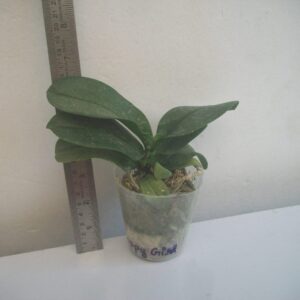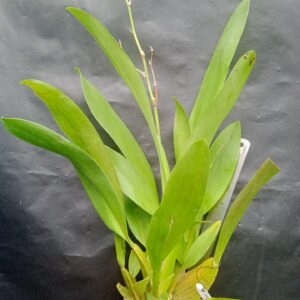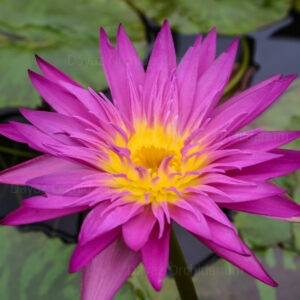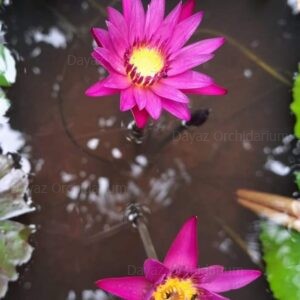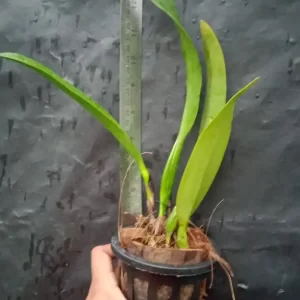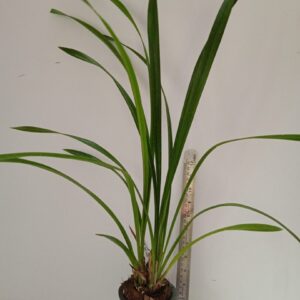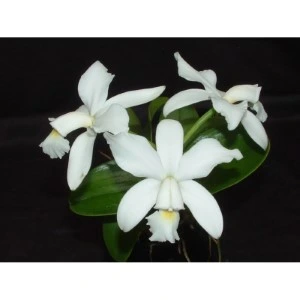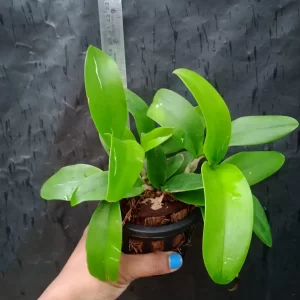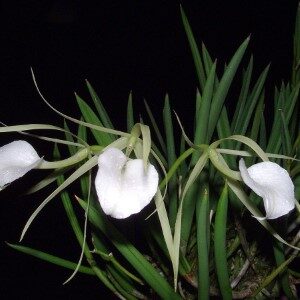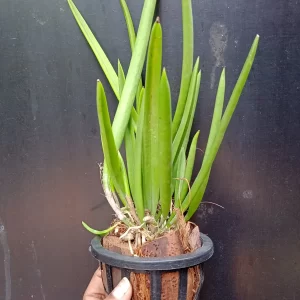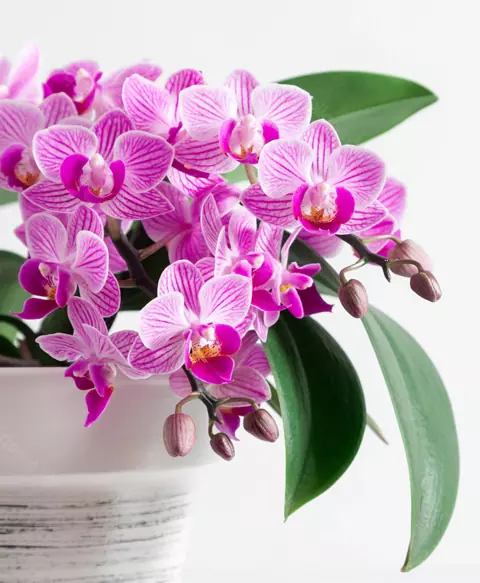Oncidium Twinkle orchids possess a unique charm that sets them apart in the world of orchids. Their specialty lies in their compact size, prolific blooming habit, and delightful fragrance, making them a favorite among orchid enthusiasts and collectors alike. Unlike some larger orchid varieties, Oncidium Twinkles are prized for their manageable size, making them ideal for growers with limited space or those seeking a charming addition to their indoor garden.
What truly sets Oncidium Twinkle orchids apart is their remarkable flowering prowess. Despite their diminutive stature, these orchids produce an abundance of petite flowers, often arranged in clusters along slender stems. Each bloom carries a distinct charm, with delicate petals adorned with intricate patterns and vibrant colors, ranging from soft whites to vibrant yellows and deep oranges. The flowers emit a sweet and captivating fragrance, reminiscent of citrus or honey, which fills the air and adds to their allure.
Growing Oncidium Twinkle White in a hot climate requires careful attention to provide the right conditions to thrive. Here’s a guide on how to grow this orchid variety in hot climates:
Lighting: Provide bright, indirect light. In hot climates, intense sunlight can be a challenge, so it’s crucial to shield the plant from direct sunlight, especially during the hottest parts of the day. Place the orchid in a location with bright, filtered light or provide shading to prevent leaf scorching.
Temperature: Oncidium Twinkle White can tolerate warm temperatures, but excessive heat can stress the plant. Ensure that daytime temperatures do not exceed 85°F to 90°F (29°C to 32°C), and nighttime temperatures remain relatively cooler, ideally between 60°F to 70°F (15°C to 21°C). Providing adequate ventilation can help lower temperatures around the plant.
Humidity: Hot climates often accompany low humidity levels, which can be challenging for orchids. Increase humidity around the plant by misting the leaves regularly or using a humidifier. You can also place the orchid on a humidity tray filled with water and pebbles to create a humid microenvironment.
Air Circulation: Good air circulation is essential, especially in hot climates, to prevent heat buildup and stagnant air around the plant. Ensure there is adequate airflow by placing the orchid in a well-ventilated area or using fans to promote air movement.
Watering: In hot climates, orchids may require more frequent watering to prevent dehydration. Water the plant thoroughly when the growing medium begins to dry out, but be careful not to overwater, as this can lead to root rot. Use a well-draining orchid potting mix and allow excess water to drain freely from the pot.
Fertilizing: Feed the orchid regularly with a balanced orchid fertilizer diluted to half strength during the growing season. Fertilize every two to four weeks to provide essential nutrients for healthy growth and blooming. Reduce or stop fertilizing during the plant’s dormancy period.
Shading: Protect the orchid from direct sunlight by providing shade during the hottest part of the day, especially if growing outdoors. Use shade cloth or place the orchid under a pergola, tree canopy, or other structures that filter sunlight.
Potting and Repotting: Repot Oncidium Twinkle White when necessary, typically when the roots outgrow the pot or the growing medium degrades. Choose a pot with ample drainage holes and use a fresh orchid potting mix. Repotting is best done in the spring or early summer when new growth emerges.
By providing the right growing conditions and care, Oncidium Twinkle White can thrive and bloom beautifully even in hot climates. With attention to detail and adjustments to accommodate the challenges of high temperatures, you can enjoy the elegance of this charming orchid variety year-round.
Preventing bud blasting in Oncidium Twinkle orchids involves maintaining stable growing conditions and addressing potential stressors that can cause buds to drop prematurely. Here are some tips to help prevent bud blasting:
Temperature Control: Fluctuations in temperature, especially extreme heat or cold, can stress the plant and cause bud blasting. Keep the temperature stable within the orchid’s preferred range, typically between 60°F to 85°F (15°C to 29°C) during the day and slightly cooler at night. Avoid placing the orchid near drafty windows, heaters, or air conditioners.
Humidity Management: Inconsistent humidity levels can also trigger bud blasting. Maintain moderate humidity around the plant, ideally between 50% to 70%. Use a humidity tray, humidifier, or mist the foliage regularly to increase humidity, especially in dry climates or during periods of low humidity.
Watering Practices: Overwatering or underwatering can stress the orchid and lead to bud blasting. Water the plant thoroughly when the growing medium is almost dry, but avoid allowing it to become completely dry or waterlogged. Ensure good drainage to prevent water from accumulating around the roots, which can cause rot.
Proper Ventilation: Adequate air circulation is essential for orchids to thrive and can help prevent bud blasting. Ensure good ventilation around the plant by placing it in a well-ventilated area or using fans to promote air movement. Stagnant air can contribute to fungal issues and stress the plant.
Lighting: Provide appropriate light levels for Oncidium Twinkle orchids, avoiding direct sunlight, which can cause excessive heat and lead to bud blasting. Opt for bright, indirect light or filtered sunlight. If growing indoors, consider using sheer curtains or blinds to diffuse sunlight and prevent leaf burn.
Pest and Disease Management: Insects, pests, and diseases can stress the plant, leading to bud blasting. Regularly inspect the orchid for signs of pests such as aphids, mealybugs, or spider mites, and treat infestations promptly with appropriate measures. Maintain good hygiene by removing dead or decaying plant material and avoiding overcrowding.
Fertilization: Proper fertilization can support healthy growth and flowering, reducing the risk of bud blasting. Use a balanced orchid fertilizer diluted to half strength and apply it according to the manufacturer’s recommendations during the growing season. Avoid overfertilizing, as it can lead to salt buildup and damage the roots.

